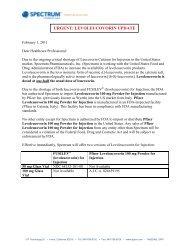Single Vial Docetaxel Injection - ION Solutions
Single Vial Docetaxel Injection - ION Solutions
Single Vial Docetaxel Injection - ION Solutions
You also want an ePaper? Increase the reach of your titles
YUMPU automatically turns print PDFs into web optimized ePapers that Google loves.
discontinuation of the <strong>Docetaxel</strong> <strong>Injection</strong> infusion and aggressive therapy. Patients with a history of<br />
severe hypersensitivity reactions should not be rechallenged with <strong>Docetaxel</strong> <strong>Injection</strong>.<br />
Hypersensitivity reactions may occur within a few minutes following initiation of a <strong>Docetaxel</strong><br />
<strong>Injection</strong> infusion. If minor reactions such as flushing or localized skin reactions occur, interruption of<br />
therapy is not required. All patients should be premedicated with an oral corticosteroid prior to the<br />
initiation of the infusion of <strong>Docetaxel</strong> <strong>Injection</strong> [see Dosage and Administration (2.6)].<br />
5.5 Fluid Retention<br />
Severe fluid retention has been reported following docetaxel therapy. Patients should be<br />
premedicated with oral corticosteroids prior to each <strong>Docetaxel</strong> <strong>Injection</strong> administration to reduce the<br />
incidence and severity of fluid retention [see Dosage and Administration (2.6)]. Patients with pre-existing<br />
effusions should be closely monitored from the first dose for the possible exacerbation of the effusions.<br />
When fluid retention occurs, peripheral edema usually starts in the lower extremities and may<br />
become generalized with a median weight gain of 2 kg.<br />
Among 92 breast cancer patients premedicated with 3-day corticosteroids, moderate fluid retention<br />
occurred in 27.2% and severe fluid retention in 6.5%. The median cumulative dose to onset of moderate<br />
or severe fluid retention was 819 mg/m 2 . Nine of 92 patients (9.8%) of patients discontinued treatment<br />
due to fluid retention: 4 patients discontinued with severe fluid retention; the remaining 5 had mild or<br />
moderate fluid retention. The median cumulative dose to treatment discontinuation due to fluid retention<br />
was 1021 mg/m 2 .<br />
Fluid retention was completely, but sometimes slowly, reversible with a median of 16 weeks<br />
from the last infusion of docetaxel to resolution (range: 0 to 42+ weeks). Patients developing peripheral<br />
edema may be treated with standard measures, e.g., salt restriction, oral diuretic(s).<br />
5.6 Acute Myeloid Leukemia<br />
Treatment-related acute myeloid leukemia (AML) or myelodysplasia has occurred in patients<br />
given anthracyclines and/or cyclophosphamide, including use in adjuvant therapy for breast cancer. In the<br />
adjuvant breast cancer trial (TAX316) AML occurred in 3 of 744 patients who received docetaxel,<br />
doxorubicin and cyclophosphamide (TAC) and in 1 of 736 patients who received fluorouracil,<br />
doxorubicin and cyclophosphamide [see Clinical Studies (14.2)]. In TAC-treated patients, the risk of<br />
delayed myelodysplasia or myeloid leukemia requires hematological follow-up.<br />
5.7 Cutaneous Reactions<br />
Localized erythema of the extremities with edema followed by desquamation has been observed.<br />
In case of severe skin toxicity, an adjustment in dosage is recommended [see Dosage and Administration<br />
(2.7)]. The discontinuation rate due to skin toxicity was 1.6% (15/965) for metastatic breast cancer<br />
patients. Among 92 breast cancer patients premedicated with 3-day corticosteroids, there were no cases of<br />
severe skin toxicity reported and no patient discontinued docetaxel due to skin toxicity.<br />
5.8 Neurologic Reactions<br />
Severe neurosensory symptoms (e.g. paresthesia, dysesthesia, pain) were observed in 5.5%<br />
(53/965) of metastatic breast cancer patients, and resulted in treatment discontinuation in 6.1%. When<br />
these symptoms occur, dosage must be adjusted. If symptoms persist, treatment should be discontinued<br />
[see Dosage and Administration (2.7)]. Patients who experienced neurotoxicity in clinical trials and for<br />
Page 9 of 46














